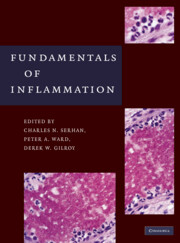Book contents
- Frontmatter
- Contents
- Contributors
- Preface
- PART I THE INFLAMMATORY RESPONSE – AN OVERVIEW
- PART II INDIVIDUAL CELL TYPES
- PART III CHEMICAL MEDIATORS
- PART IV IMMUNOPHARMACOLOGY
- PART V INFLAMMATORY DISEASES/HISTOLOGY
- 20 Lung
- 21 Neural Inflammation, Alzheimer's Disease, and Stroke
- 22 Rheumatoid Arthritis/SLE
- 23 Gastrointestinal Inflammation and Ulceration: Mediators of Induction and Resolution
- 24 Inflammatory Skin Diseases
- 25 Kidney Glomerulonephritis and Renal Ischemia
- 26 Inflammation in Cardiovascular Diseases
- PART VI ANIMAL MODELS OF INFLAMMATION
- Index
- References
24 - Inflammatory Skin Diseases
from PART V - INFLAMMATORY DISEASES/HISTOLOGY
Published online by Cambridge University Press: 05 April 2014
- Frontmatter
- Contents
- Contributors
- Preface
- PART I THE INFLAMMATORY RESPONSE – AN OVERVIEW
- PART II INDIVIDUAL CELL TYPES
- PART III CHEMICAL MEDIATORS
- PART IV IMMUNOPHARMACOLOGY
- PART V INFLAMMATORY DISEASES/HISTOLOGY
- 20 Lung
- 21 Neural Inflammation, Alzheimer's Disease, and Stroke
- 22 Rheumatoid Arthritis/SLE
- 23 Gastrointestinal Inflammation and Ulceration: Mediators of Induction and Resolution
- 24 Inflammatory Skin Diseases
- 25 Kidney Glomerulonephritis and Renal Ischemia
- 26 Inflammation in Cardiovascular Diseases
- PART VI ANIMAL MODELS OF INFLAMMATION
- Index
- References
Summary
PSORIASIS
Psoriasis is a common, chronic inflammatory skin disease with an overall prevalence of 2%–3% of the world population with a higher prevalence in the United States and Canada (4.6% and 4.7%, respectively) compared to a lower prevalence of 0.4–0.7% in Africans, African Americans, and Asians [1].
Psoriasis can appear at any age but there is a tendency toward a peak at ages 20–30 years and then again at ages 50–60 years. It has a chronic relapsing and remitting nature in response to a variety of stressors. It is rarely life threatening but is associated with a high degree of morbidity. Psoriasis can be limited to skin but can also be associated with debilitating arthritis in 5%–30% of sufferers. Its burden on health care economy is on par with cardiovascular disease, diabetes, and depression.
Its aetiology is multifactorial, combining genetics, immunity, and environmental triggers. There is a 2–3-fold increase in risk of developing psoriasis in monozygotic versus dizygotic twins, and results of WGAS (whole genome wide association scans) show that psoriasis is a complex genetic disease [2]. At least 19 gene loci have been implicated but replication of a single locus has been provided for only a few of these. One of these regions lies on a 210-kb stretch of DNA on the short arm of chromosome 6 (termed PSORS1) which includes genes coding for HLA-Cw6, a potential immunological candidate gene, and corneodesmosin, a potential epidermal structure related candidate gene [3].
- Type
- Chapter
- Information
- Fundamentals of Inflammation , pp. 299 - 303Publisher: Cambridge University PressPrint publication year: 2010



